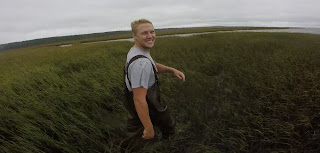The project that I developed in the fall
semester of 2017 investigated the protective services of coastal marshes during
extreme storm events. This project employed the high-resolution numerical model
X-Beach (Roelvink et al,. 2009) to simulate nearshore processes operating in
coastal marshes such as erosion, wave transformation over the vegetation field,
and flooding. The goal was to successfully setup and calibrate the numerical
model to simulate coastal hazards at a protective area of the Chesapeake Bay
and to validate the results of the model with in-situ observations collected in
the field during severe storm events.
The OSCAR fellowship gave me the opportunity
of joining Dr. Ferreira’s Flood Hazards Research Lab (FHRL) as an undergraduate
research assistant. During the fall semester, I widely improved my
understanding about the coastal protection benefits that nature-based defenses
including saltmarhes potentially provide for during extreme storm events.
Furthermore, growing up at the Virginia Beach region and having a passion for
water and the environment, I have been always interested in the coastal water
research which led me to pursue this project. My next step is to continue improving my
understanding of the physical processes operating in coastal areas through the
analysis of the outcomes of hydrodynamic numerical models along with field
observations. A normal week would consist of going the Flood Hazards Research
Lab to test the model and try to compare it to the field results. Most of the
time I would either read more Literature on past research using this model, or
I would seek guidance from the PhD’s in the lab.
The outcomes from the current project show
how the local vegetation within the marsh efficiently attenuate waves from
storm surges, but the highly complex interactions between vegetation and
hydrodynamics require further investigation in order to fully understand these
physical processes.

